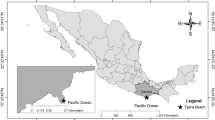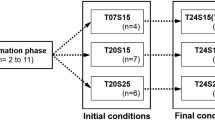Abstract
The knowledge that the initial mating in planktonic copepods may be inadequate to permit realization of a female's total reproductive potential, and that remating can occur, has important implications for both population dynamics and speciation studies. Acartia tonsa Dana females in controlled laboratory experiments were successfully remated after becoming totally infertile following approximately 3 weeks of highly fertile production. Large numbers of viable nauplii resulted from these second matings.
Similar content being viewed by others
Literature cited
Heinle, D. R.: Population dynamics of exploited cultures of calanoid copepods. Helgoländer wiss. Meeresunters. 20, 360–372 (1970).
Marshall, S. M. and A. P. Orr: On the biology of Calanus finmarchicus. VII. Factors affecting egg production. J. mar. biol. Ass. U.K. 30, 527–549 (1952).
Woodhouse, C. D.: Personal communication and Ph. D. dissertation (in preparation).
Zillioux, E. J. and D. F. Wilson: Culture of a planktonic calanoid copepod through multiple generations. Science, N.Y. 151, 996–998 (1966).
Author information
Authors and Affiliations
Additional information
Communicated by J. Bunt, Miami
Rights and permissions
About this article
Cite this article
Wilson, D.F., Parrish, K.K. Remating in a planktonic marine calanoid copepod. Marine Biology 9, 202–204 (1971). https://doi.org/10.1007/BF00351379
Accepted:
Issue Date:
DOI: https://doi.org/10.1007/BF00351379




